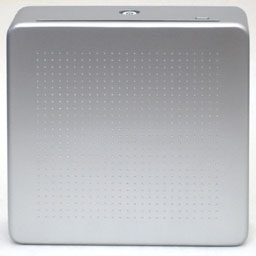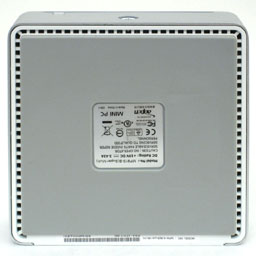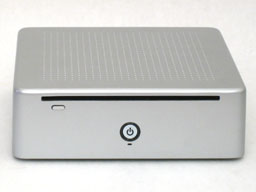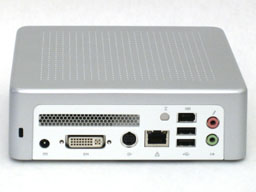Updated: AOpen MiniPC – Imitation is the Sincerest Form of Flattery
by Jarred Walton on March 3, 2006 12:05 AM EST- Posted in
- Systems
Appearance and System Specifications
To say that the AOpen MiniPC looks similar to the Mac Mini is an understatement. AOpen's own product marketing material contains numerous photographs comparing the two. Not everyone thinks that tiny PCs are cool looking or even necessary, but for those who do, the AOpen MiniPC is a very nice looking unit. Depending on where you purchase the MiniPC, you can find them in a variety of colors. Black, white, and silver are the most common, and the unit that we received is silver.
Other than the rear ports and the glowing blue power/HDD lights on the front, the case is a uniform silver. Also found on the front of the unit is the slot-load optical drive access and the accompanying eject button. The top has a grid of small indentations to add a bit of visual flare, while the sides and front are unadorned brushed aluminum. The bottom of the case has a rubberized non-slip pad with venting around the edges and a sticker containing product details, and that's about it. The case is, of course, very small, and you could easily hide it from view if desired, just like the Mac Mini. Technically, the MiniPC is slightly smaller than the Mac Mini (by about .5" in height), but basically, the system size is a tie.
One item that needs to be pointed out is the choice of interface. There are no legacy ports on the system; other than video and audio connections, the only interface for input devices and other components is provided by two USB 2.0 ports. Only two? That's right: if you want more than two devices, you're going to need a USB hub of some form. In fact, since you're going to use a mouse and keyboard for at least one port, a USB hub is almost required for expansion. You might try getting a keyboard with a couple of USB ports, but most likely, they will be USB 1.1, so you won't want to use them for high bandwidth devices. For testing, a Logitech Bluetooth keyboard and mouse combo was used, so that did leave a spare USB port. If you want to do anything more with the MiniPC, grab a powered USB 2.0 hub with at least four ports; they typically cost around $10 to $30, so it's not a major expense.
The Realtek ALC655 audio chip in the unit is capable of 5.1 sound, but apparently lack of room for the audio ports leaves only a speaker/headphone jack and a microphone jack. That should allow for up to 4.1 sound, using the microphone port for the rear/side speakers, but most users will either want 5.1 or 2.1 so the inclusion of only two audio jacks is a definite limitation. The unoccupied spot to the left of the USB/Firewire port is for the WiFi antenna, and it seems like AOpen could have added a third audio jack without too much difficulty, as there is still a bit of open space on the back plate. To the left of the plate you can see the exhaust port for the CPU HSF, and along the bottom are the DVI port, TV-out, LAN, and power sockets.
The TV-out takes an "octopus" adapter that splits the output into S-VIDEO, Component, or Composite, and a DVI to VGA adapter is included in the package. Both the component and DVI connections were tested with an HDTV, and the component was found to be preferable (as the DVI port would lose resolution settings between reboots). Notably lacking is support for S/PDIF output and legacy PS/2 ports for the keyboard and mouse. The audio overall is the weakest link, but the video aspects do help make up for it.
While the size and appearance may be similar to the Mac Mini, the insides are quite different. In typical Wintel fashion, AOpen has cloned the original Mac Mini with a system that is going to be faster in nearly every area. Here are the specifications.
If you're looking for a screaming fast computer, this isn't it. If you want to play a lot of games, once again, you're barking up the wrong tree. Taking all of the functionality in your standard computer and compressing it into a size that's about as big as your typical 5.25" DVD ROM drive requires some compromises. You get integrated graphics, a 2.5" hard drive, DVD burner, a processor and memory... and that's really about it. There is an option to have a WiFi card installed as well. The good news is that there are plenty of applications that don't require anything more than those specs.
One item that we have to clarify is that the system we received came with a Pentium M 740 (1.733 GHz Dothan) processor, and most of the online models as well as AOpen's documentation list the Pentium M 740 as the standard "high-end" processor. However, it appears that the system is capable of running faster CPUs, as there are a few European sites selling the MP915 with up to a Pentium M 760 (2.0 GHz). We didn't encounter any heat-related issues during testing, so other than cost there shouldn't be any reason for the MiniPC to not support the top Pentium M chips.
To say that the AOpen MiniPC looks similar to the Mac Mini is an understatement. AOpen's own product marketing material contains numerous photographs comparing the two. Not everyone thinks that tiny PCs are cool looking or even necessary, but for those who do, the AOpen MiniPC is a very nice looking unit. Depending on where you purchase the MiniPC, you can find them in a variety of colors. Black, white, and silver are the most common, and the unit that we received is silver.
Other than the rear ports and the glowing blue power/HDD lights on the front, the case is a uniform silver. Also found on the front of the unit is the slot-load optical drive access and the accompanying eject button. The top has a grid of small indentations to add a bit of visual flare, while the sides and front are unadorned brushed aluminum. The bottom of the case has a rubberized non-slip pad with venting around the edges and a sticker containing product details, and that's about it. The case is, of course, very small, and you could easily hide it from view if desired, just like the Mac Mini. Technically, the MiniPC is slightly smaller than the Mac Mini (by about .5" in height), but basically, the system size is a tie.
 |
 |
| Click on images to enlarge. | |
One item that needs to be pointed out is the choice of interface. There are no legacy ports on the system; other than video and audio connections, the only interface for input devices and other components is provided by two USB 2.0 ports. Only two? That's right: if you want more than two devices, you're going to need a USB hub of some form. In fact, since you're going to use a mouse and keyboard for at least one port, a USB hub is almost required for expansion. You might try getting a keyboard with a couple of USB ports, but most likely, they will be USB 1.1, so you won't want to use them for high bandwidth devices. For testing, a Logitech Bluetooth keyboard and mouse combo was used, so that did leave a spare USB port. If you want to do anything more with the MiniPC, grab a powered USB 2.0 hub with at least four ports; they typically cost around $10 to $30, so it's not a major expense.
The Realtek ALC655 audio chip in the unit is capable of 5.1 sound, but apparently lack of room for the audio ports leaves only a speaker/headphone jack and a microphone jack. That should allow for up to 4.1 sound, using the microphone port for the rear/side speakers, but most users will either want 5.1 or 2.1 so the inclusion of only two audio jacks is a definite limitation. The unoccupied spot to the left of the USB/Firewire port is for the WiFi antenna, and it seems like AOpen could have added a third audio jack without too much difficulty, as there is still a bit of open space on the back plate. To the left of the plate you can see the exhaust port for the CPU HSF, and along the bottom are the DVI port, TV-out, LAN, and power sockets.
The TV-out takes an "octopus" adapter that splits the output into S-VIDEO, Component, or Composite, and a DVI to VGA adapter is included in the package. Both the component and DVI connections were tested with an HDTV, and the component was found to be preferable (as the DVI port would lose resolution settings between reboots). Notably lacking is support for S/PDIF output and legacy PS/2 ports for the keyboard and mouse. The audio overall is the weakest link, but the video aspects do help make up for it.
While the size and appearance may be similar to the Mac Mini, the insides are quite different. In typical Wintel fashion, AOpen has cloned the original Mac Mini with a system that is going to be faster in nearly every area. Here are the specifications.
| AOpen MiniPC MP915 | |
| Motherboard: | AOpen propietary 915GM+ICH6M |
| Processor: | Intel socket 479 (Celeron M to Pentium M 740) |
| RAM: | 1 X DDR2 SO-DIMM (Maximum 1GB of RAM) |
| Hard Drive: | 2.5" PATA Notebook HDD |
| Graphics: | 915GM (Intel GMA900) |
| Optical Drive: | Slim CD/DVD slot load |
| Expansion Slots: | 1 X Mini-PCI (for WiFi) |
| Audio: | Realtek ALC655 AC'97 2CH (Speaker/Headphones + Microphone) |
| Power Suply: | 65W (19V, 3.5A) External Adapter Internal connections from motherboard to HDD and ODD |
| Front Ports: | None. Power Button, HDD Activity LED, ODD Eject Button |
| Rear Ports: | 2 X USB2.0 2 X 3.5mm Audio (speakers and microphone) LAN (GbE) 1 X DVI-D and 1 X TV-Out (S-VIDEO, Composite, Component) 1 X Optional WiFi Antenna |
If you're looking for a screaming fast computer, this isn't it. If you want to play a lot of games, once again, you're barking up the wrong tree. Taking all of the functionality in your standard computer and compressing it into a size that's about as big as your typical 5.25" DVD ROM drive requires some compromises. You get integrated graphics, a 2.5" hard drive, DVD burner, a processor and memory... and that's really about it. There is an option to have a WiFi card installed as well. The good news is that there are plenty of applications that don't require anything more than those specs.
One item that we have to clarify is that the system we received came with a Pentium M 740 (1.733 GHz Dothan) processor, and most of the online models as well as AOpen's documentation list the Pentium M 740 as the standard "high-end" processor. However, it appears that the system is capable of running faster CPUs, as there are a few European sites selling the MP915 with up to a Pentium M 760 (2.0 GHz). We didn't encounter any heat-related issues during testing, so other than cost there shouldn't be any reason for the MiniPC to not support the top Pentium M chips.












54 Comments
View All Comments
JarredWalton - Friday, March 3, 2006 - link
"...*original* Mac Mini...."The Core Duo version was officially launched this past week.
mlittl3 - Friday, March 3, 2006 - link
Jarred,Since the article was posted today, I don't think anyone is going to care about the original Mac Mini. The computer industry moves and it moves fast. If Aopen's mini is better than what Apple put out in the past, then Apple has solved that problem with the new Mac Mini. That is the important issue today.
JarredWalton - Friday, March 3, 2006 - link
I Aopen had sent this to me in the past week, I wouldn't have bothered with the review. I've been putting this unit through it's paces for a lot more than a week, so the launch of the new Mac Mini is a non-factor. I mentioned it, I suggested it's a better choice right now (at least, I feel I did), and I really wouldn't recommend this model to anyone unless it were to sell for $650 or less. (Core Solo is for all intents and purposes equal to Dothan, so if it matches the Core Solo priced Mac Mini it would be fine.)JarredWalton - Friday, March 3, 2006 - link
First word: "I" should be "If..."Update #2: I'm betting not many people bothered reading the whole article, so they missed the comments on page 10 implying that the new Mac Minis are clearly faster. ("...with the recent launch of the Intel-based Mac Minis, that advantage is going to be short-lived.") I've updated the conclusion to make more specific mention of the Core Duo Mac Mini priced at $800.
Sunbird - Friday, March 3, 2006 - link
Looks like they followed my http://www.dailytech.com/article.aspx?newsid=937">advice on the styling (I can dream cant I?) and its not silver and blue.I like it.
Sunbird - Friday, March 3, 2006 - link
A question though:Is all the hardware OSx86 compatible?
Then you could enjoy the best of both worlds on one little box...
plinden - Friday, March 3, 2006 - link
I'm afraid I'm going to have to sound like an Apple fanboi now, but AOpen are still playing catchup with Apple:So to compare the specs:
Processor: Intel socket 479 (Celeron M to Pentium M 740) - Intel Core Solo/Duo
RAM: 1 X DDR2 SO-DIMM (Maximum 1GB of RAM) - 2 GB RAM Max
Hard Drive: 2.5" PATA Notebook HDD - Same HD
Graphics: 915GM (Intel GMA900) - Intel GMA950
Optical Drive: Slim CD/DVD slot load - same or similar, i.e. combo or superdrive
Expansion Slots: 1 X Mini-PCI (for WiFi) - no expansion slot but WIFI and bluetooth included by default
Audio: Realtek ALC655 AC'97 2CH (Speaker/Headphones + Microphone) - S/PDIF output
Power Suply: 65W (19V, 3.5A) External Adapter - 85W power supply
Internal connections from motherboard to HDD and ODD
Front Ports: None. Power Button, HDD Activity LED, ODD Eject Button - same
Rear Ports: 2 X USB2.0 - 4xUSB2.0
2 X 3.5mm Audio (speakers and microphone)
LAN (GbE) - same
1 X DVI-D and 1 X TV-Out (S-VIDEO, Composite, Component) - 1xDVI, no TV out
1 X Optional WiFi Antenna wireless G included
All for $599 - $799 (for 512MB RAM).
Despite the moaning over on Mac forums, this is still a much better deal than the MiniPC.
mlittl3 - Friday, March 3, 2006 - link
The hard drive in the Mac Mini is SATA not PATA.JarredWalton - Friday, March 3, 2006 - link
Which is basically what I say in the conclusion. This MP915 has been done for about three months now, and available on the market for just over a month (and a bit longer in Europe/Asia). MP945 will go up against the new Mac Mini, but the real question is whether or not it can come close to matching Apple's price. I'd like $850 with Core Duo 1.86 GHz (or higher), XP Home, 60+ GB HDD, DVD+RW, and 1GB RAM standard. I've said as much to AOpen, so we'll see if they can do that or not.JarredWalton - Friday, March 3, 2006 - link
Ack!Bold off Let's see if that works.... :p